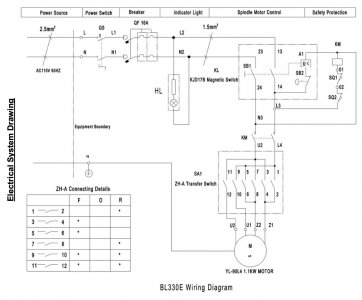Some of you may know I purchased a cx709 that BusyBee had on clearance because it had a problem.
BB's explanation of the issue on this machine was that it couldn't get to top speed, but everything else worked. The guy at BB stated that it actually would get to top speed, but it just took awhile.
I purchased the lathe, figuring it was a motor problem, and because I have a spare motor I wasn't concerned.
So I just got around to cleaning the machine and testing it. Turns out, it will not run on the 3 top speeds. (850, 1100 & 1650). On any of these settings, the speed fluctuates drastically for about 5 seconds then trips the breaker. I can't attach videos of the issue, but they can be seen here & here.
I have my theory as to what the problem is, but don't have time right now to check it out, so I thought I'd see what others think the problem may be. You may come up with something I didn't think of.
I have ruled out a mechanical problem because the lathe works fine at the 640rpm setting, but fails at the 850rpm setting. These two settings use the same gearset and is only a belt change, so nothing mechanical really changes. What I think happens is that as the speed setting increases, the torque requirement for the motor becomes greater and it just can't handle the increased torque load at the top 3 settings.
I have already checked the start & run capacitors and they seem ok. Granted, I only checked with an ohmmeter, but they did pass that test, and look perfectly fine.
What I don't have time to check right now (and what I think the problem is), is the centrifugal switch. I'm thinking it may be opening too quickly and dropping out the start capacitor before the motor has enough momentum/torque to be able to run on the Run capacitor.
That's where I'm headed next, but I am open to all opinions.
BB's explanation of the issue on this machine was that it couldn't get to top speed, but everything else worked. The guy at BB stated that it actually would get to top speed, but it just took awhile.
I purchased the lathe, figuring it was a motor problem, and because I have a spare motor I wasn't concerned.
So I just got around to cleaning the machine and testing it. Turns out, it will not run on the 3 top speeds. (850, 1100 & 1650). On any of these settings, the speed fluctuates drastically for about 5 seconds then trips the breaker. I can't attach videos of the issue, but they can be seen here & here.
I have my theory as to what the problem is, but don't have time right now to check it out, so I thought I'd see what others think the problem may be. You may come up with something I didn't think of.
I have ruled out a mechanical problem because the lathe works fine at the 640rpm setting, but fails at the 850rpm setting. These two settings use the same gearset and is only a belt change, so nothing mechanical really changes. What I think happens is that as the speed setting increases, the torque requirement for the motor becomes greater and it just can't handle the increased torque load at the top 3 settings.
I have already checked the start & run capacitors and they seem ok. Granted, I only checked with an ohmmeter, but they did pass that test, and look perfectly fine.
What I don't have time to check right now (and what I think the problem is), is the centrifugal switch. I'm thinking it may be opening too quickly and dropping out the start capacitor before the motor has enough momentum/torque to be able to run on the Run capacitor.
That's where I'm headed next, but I am open to all opinions.

